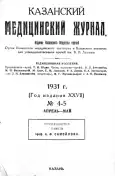О влиянии сердечных нервов лягушки на ток покоя обездвиженного желудочка
- Авторы: Редакционная к.1
-
Учреждения:
- КГУ
- Выпуск: Том 27, № 4-5 (1931)
- Страницы: 410-414
- Тип: Статьи
- URL: https://ogarev-online.ru/kazanmedj/article/view/82736
- DOI: https://doi.org/10.17816/kazmj82736
- ID: 82736
Цитировать
Полный текст
Аннотация
Если раздражать двигательный нерв, несущий возбуждение к локально поврежденной скелетной мышце, то, как известно, уменьшается ее ток покоя; происходит отрицательное колебание тока покоя. Иначе обстоит дело при раздражении тормозного нерва сердца. В этом случае Gaskell получил увеличение тока покоя. Его классический опыт был проведен на предсердиях черепашьего сердца, находящихся в состоянии длительной остановки. Последнее обстоятельство весьма важно, так как сама по себе остановка1) или даже замедление ритма сердечных сокращений уже изменяет величину тока покоя. Длительную остановку предсердий Gaskell достигал тем, что проводил разрез между синусом и предсердиями, щадя при этом тот соединительнотканный тяж, который пробегает по задней поверхности сердца и содержит в себе среди сосудов сердечную ветвь блуждающего нерва. Таким образом, предсердия, лишенные синусного импульса, естественно сохраняют связь с блуждающими нервами. Если теперь повредить верхушку предсердий и раздражать блуждающий нерв, то ток покоя увеличивается. Gotch не мог подтвердить наблюдения Gaskell’n, что по мнению Bourdon Sanderson’a зависело от малой чувствительности капиллярного электрометра, которым пользовался в своих опытах Gotch. Вскоре после того как был введен в физиологическую методику струнный гальванометр, ряд авторов (Meck u. Eysteг, Самойлов2) совместно с Сергеевым) более подробно исследовали на сердце черепахи колебание тока покоя я вполне подтвердили, по крайней мере со стороны фактической, все то, что в свое время было описано Gaskel Ten, Недавно появилась работа Einthoven’а и Rademakeг’а, посвященная этому вопросу. Эти авторы приходят к заключению, что при раздражении блуждающего нерва увеличение тока покоя зависит исключительно от сокращения лег ких, которые, увлекая за собой суспендированные предсердия, растягивают их; растяжение же сердечной мышцы, как и растяжение вообще мышечной ткани, дает нарастание тока покоя. Эта работа заставила еще раз вернуться А. Ф Самойлова к гаскелевскому феномену. В 1917 г. А. Ф. Самойлов подтверждает существование сократительной способности черепашьих легких под влиянием блуждающего нерва; действительно, рычажек, соединенный с легкими, в ответ на раздражение блуждающего нерва поднимается кверху, но из приведенных кривых совершенно ясно, что нет никакого параллелизма между этим движением рычажка и отклонением струны гальванометра, вызываемым колебанием тока покоя предсердий. Сокращение легкого может искажать картину феномена Гаскеля, но существование последнего, как это явствует из цитируемой работы, не подлежит никакому сомнению. В этом окончательно убеждает нас опыт, поставленный А. Ф. Самойловым на изолированном от легких сердце черепахи с сохранением обоих блуждающих нервов. Этот опыт ясно показывает, „что Гаскель в свое время правильно наблюдал и правильно заключал: блуждающий нерв при его раздражении вызывает такое изменение сердечной мышцы находящегося в покое предсердия черепахи, которое сопровождается увеличением первоначального электрического тока покоя“4).
Ключевые слова
Полный текст
Открыть статью на сайте журналаОб авторах
коллегия Редакционная
КГУ
Автор, ответственный за переписку.
Email: info@eco-vector.com
физиологическая лаборатория
Россия, КазаньСписок литературы
- Prof. A. Sагаоj1оff. Zentralbl. f. Physiol. Bd. XXVII Nr llr 1913.
- A. Samojloff. Pflüg. Arch. f. d. g. Physiо1. B. 199, H. 6, S. 582, 1923.
- W. Einthoven u. A. Rade maker. Ibid. B. 166, S. 109, 1917.
- A. Ф. Самойлов. Известия Академии Наук. 1917, стр. 1275,
- Schäffer. Н. Pflüg. Arch. f. d. g. Physiol. B. 216. H. 4/5, S. 479, 1927
- F. Hofmann. Ibid. B. 60, S. 139, 1895.
- KräupI, F. Ibid. B. 217, H. 3/4, S. 327, 1927.
- A. Samojloff. Ibid. Bd. 155, S. 471. 1914.
- A. Samоj1оff. Ibid. B. 135, 417, 1910.
Дополнительные файлы






